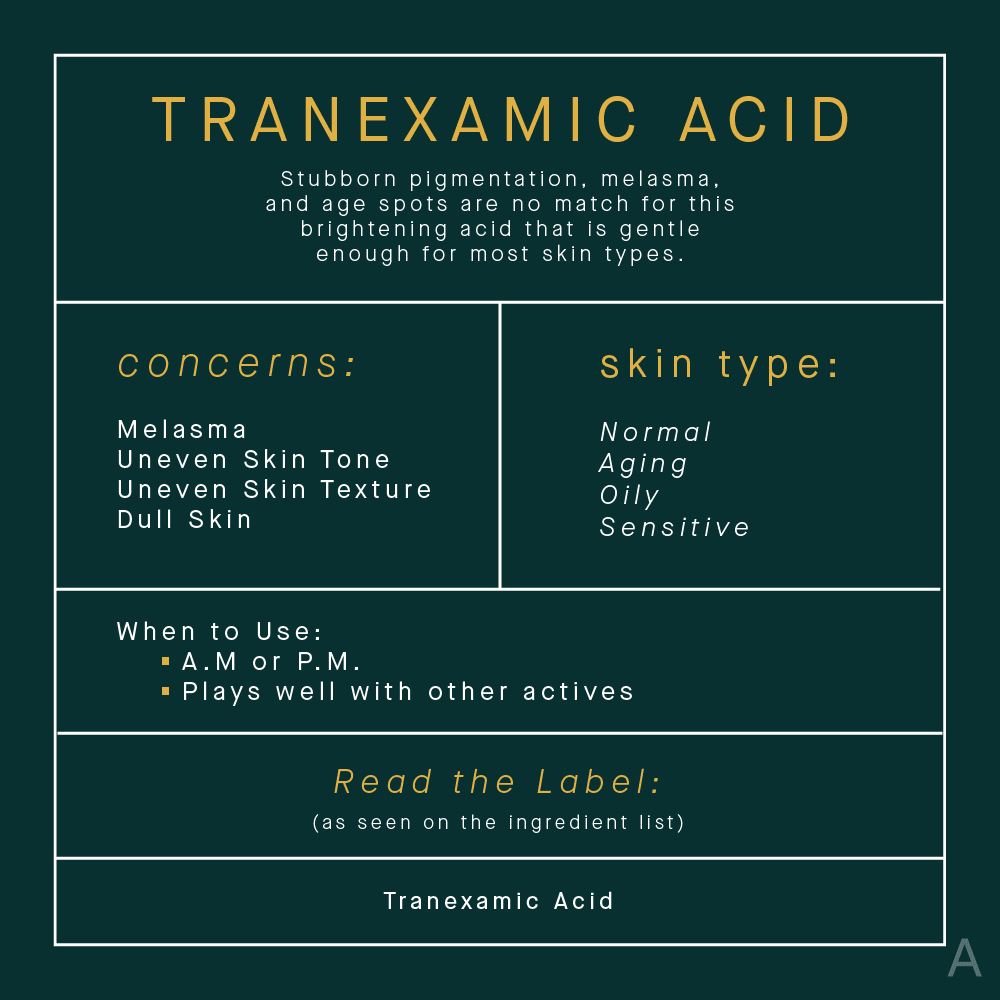 Clear + Brilliant®
Clear + Brilliant®Read The Label: All Of Your Tranexamic Acid Questions Answered
While vitamin C has long been seen as the first line of defense when it comes to treating pigmentation, this under-the-radar acid will likely become your new fave.
Feel like you need a dictionary every time you look at the ingredient list of a beauty product? Still unsure of the difference between retinol and retinoids? What about the unique benefits of vitamins B, C, and E? Are alpha and beta hydroxy acids the same thing? The skincare aisle can be overwhelming, but you don’t need a PhD in cosmetic chemistry to navigate it. With expert help, The AEDITION is demystifying and simplifying the beauty industry — one label at a time.
While fan-favorite acids like salicylic and hyaluronic are well known for their acne-busting and hydrating powers, respectively, tranexamic acid is still more of an unknown in the skincare space. It’s under-the-radar status is not all that surprising when you consider the fact that, until fairly recently, it’s most popular use was as a clotting medication for women with heavy menstrual bleeding. So, how did tranexamic acid become a dermatologist darling for treating stubborn pigmentation? The AEDITION asked the experts.
What Is Tranexamic Acid?
Tranexamic acid (also referred to as TXA) is a synthetic derivative of the amino acid, lysine, and it was first synthesized in 1962 by Japanese researchers and husband and wife team Shosuke and Utako Okamoto. At the time (and to this day), TXA can be used as an oral medication used to treat excessive blood loss from trauma, surgery, postpartum bleeding, and heavy menstruation. Belonging to a class of drugs known as antifibrinolytics, tranexamic acid works by slowing down the breakdown of blood clots, which, in turn, helps prevent prolonged bleeding.
When applied topically to the skin, tranexamic acid has a very different effect. It “can inhibit UV-induced melanin synthesis, which will block the interaction of keratinocytes and melanocytes — the cells that produce melanin in the skin,” explains Shuting Hu, PhD, a cosmetic chemist and co-founder of Acaderma.
The Benefits of Tranexamic Acid in Skincare
Given its ability to interrupt the chemical pathways that cause pigmentation in the skin, tranexamic acid is most frequently used to treat discoloration, including dark spots, melasma, and uneven skin texture. “Hyperpigmentation is caused by the excess production of melanin in the skin and can be triggered by UV exposure, acne, hormonal changes, or prescription drugs,” Dr. Hu shares.

In the case of melasma, which is a notoriously tricky condition to treat, exactly how TXA works is still somewhat of a mystery. “While the mechanism is not completely clear, oral tranexamic acid has been shown to be an effective treatment for people who suffer from melasma, a condition where the body makes extra pigment,” explains Joshua Zeichner, MD, a board certified dermatologist and director of cosmetic and clinical research at the Mount Sinai Department of Dermatology. “It is thought that tranexamic acid may provide antioxidant benefits or perhaps may lower delivery of heat to the skin by decreasing blood flow.”
And then there are the topical use cases. While tranexamic acid is certainly not the first skincare ingredient that promises to lighten pigmentation, it is one of the most inclusive. “[It] helps decrease the production of melanin in the skin in a much more gentle and effective manner than some other treatments available on the market,” Dr. Hu notes.
The Best Candidates for Tranexamic Acid
It should come as no surprise that tranexamic acid is most useful for those dealing with unwanted pigmentation — though Dr. Zeichner notes that people taking hormonal birth control should not use the oral version. “Because it poses a potential clotting risk, anyone with clotting disorders or who is on an oral contraceptive pill should not take the medicine,” he cautions. “Estrogen-containing oral contraceptive pills may increase the risk of a blood clot.”
The topical version of tranexamic acid, however, is likely still fair game. Tranexamic acid is generally considered safe and effective for most skin types, but those with very sensitive skin should be mindful. Some users report irritation, dryness, and flaky skin as the side effects of using a product with tranexamic acid.
How to Find the Right Tranexamic Acid Product
The most important aspect of picking the right tranexamic acid is checking the ingredient list and formulation. “When shopping for products that include tranexamic acid, look for a concentration of around 0.5 to 2.5 percent,” Dr. Hu says. “This potency range will be effective and still gentle on the skin.”
Another thing to keep in mind? Tranexamic acid works well with many other active ingredients. “Serums that combine tranexamic acid with other brightening ingredients such as vitamin C, kojic acid, or niacinamide will target discoloration, even out the skin tone, and reduce inflammation,” she adds. Depending on your skin type, combining tranexamic acid with other acids may be irritating, so consider incorporating one at a time to start. Learn more in our guide to safely adding skincare ingredients into your routine.
How to Add Tranexamic Acid to Your Skincare Routine
Tranexamic acid is versatile, but it’s important to make sure it fits in well with the rest of your routine. “I recommend using tranexamic acid one to two times per day,” Dr. Hu says. “It can be used either in the morning or at night, whatever best fits your routine.” More likely than not, you’ll find the ingredient in serums and targeted treatments. “I typically recommend using a tranexamic acid in serum, like Acaderma’s Star Light Spot Corrector, since it can be layered before your other products,” she shares.
The way you apply tranexamic acid depends on the nature of your discoloration. “For people who have mottled hyperpigmentation, which are subtle dark spots throughout the entire face, I recommend applying your brightening serum to the entire area,” Dr. Zeichner says. His pick? The La Roche-Posay Glycolic B5 Serum. “For someone who has an individual, well-defined patch, a spot treatment method can be used,” he adds.
Both experts agree that tranexamic acid tends to work best when paired with other brightening ingredients. “Especially when treating hyperpigmentation, a multi-prong approach is best,” Dr. Zeichner explains. He suggests using ingredients that “complement each other to reduce pigmentation production, enhance cell turnover, and calm Inflammation.” Some products that fit the bill:
- The Good Molecules Discoloration Correcting Serum is a TikTok-favorite, and it combines a tranexamic acid complex with niacinamide to treat and prevent pigmentation.
- Peter Thomas Roth’s PRO Strength Niacinamide Discoloration Treatment blends the acid with niacinamide and kojic acid for a gentle but effective brightening effect.
- Tranexamic acid is joined by bakuchiol, niacinamide, vitamin E, and milk thistle to target brown and gray patches in Paula's Choice Discoloration Repair Serum.
But you don’t always have to do everything in one step. “In addition to brightening serums, sunscreen is also a must,” Dr. Zeichner adds. “And I usually recommend antioxidant serums that contain ingredients like vitamin C in the morning.” Here at The AEDITION, we’re fans of the Renée Rouleau Vitamin C & E Treatment and BeautyStat Universal C Skin Refiner.
The Takeaway
Tranexamic acid may have started as a medication to help stop heavy bleeding, but it can also be used in skincare to treat discoloration and dark spots. In topical form, it works best when paired with other brightening ingredients in a serum or spot treatment form. Be sure the formula contains an appropriate amount of the acid (at least 0.5 percent) in order to fully enjoy the skin tone evening benefits.
All products featured are independently selected by our editors, however, AEDIT may receive a commission on items purchased through our links.
More Related Articles
Related Procedures

AI Plastic Surgeon™
powered by'Try on' aesthetic procedures and instantly visualize possible results with The AI Plastic Surgeon, our patented 3D aesthetic simulator.


